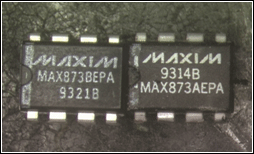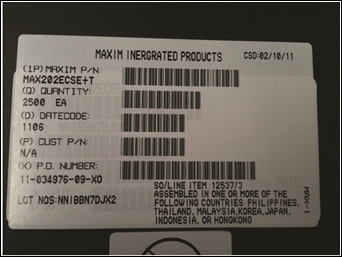Counterfeit ICs—the Serious Problem that Only We Can Make Go Away
Counterfeit ICs—the Serious Problem that Only We Can Make Go Away
by
John OBoyle
Oct 1 2012
Abstract
Counterfeiting as an international industry covers virtually everything made or manufactured, from auto parts to purses and watches to prescription drugs. In contrast to other counterfeit items, the ramifications of a counterfeit IC device failure in an electronic system are more than just inconvenience or a minor loss of money. This article explains the dangers of counterfeit ICs. It also discusses how to identify and avoid the purchase of these devices.
Introduction
At least once a week I receive a request or inquiry from customers' QA engineers concerning the pedigree of a Maxim part that they suddenly find is not working properly. In almost every case it turns out that the troublesome device is not a genuine Maxim part. Most of the time, the part is a remarked device with the same package that Maxim uses. Every once in a while the part is a Maxim die, but a lower grade remarked to a higher grade. In short, the problematic device is a counterfeit.
Counterfeiting as an international industry covers virtually everything made or manufactured, from auto parts to purses and watches to prescription drugs. In 2006 the total dollar revenue of counterfeiters was estimated to be in the $700 billion range and growing rapidly. Conservative estimates place the annual growth at 10%, even through the recession as people sought lower prices for goods. Projecting that growth forward from 2006, the 2011 revenue number is somewhere close to $1125 billion. At this level if one were to rank the counterfeit industry in terms of GDP, this "Counterfeit Nation" would rank number 15 in the world's economy and just above South Korea's 2011 GDP estimate of $1116 billion.¹
Counterfeit electronics is a big industry, but a small part of the overall total. Nonetheless, the ramifications of a counterfeit IC device failure in an electronic system are more than inconvenience or minor loss of money.
Know What to Look For
The counterfeiters are getting better, more skilled. They have improved machines for demarking and remarking which are so good that the altered top marking looks genuine. They can now micromachine the laser mark off a package and then remark with their own laser the part number, the logo, and the date code as they desire. Figure 1 shows a real Maxim part on the left with grade "B" and the counterfeit part on the right changed to grade "A."

Figure 1. Valid Maxim part with correct grade B on the left and counterfeit part with grade A on the right. Note the evidence of the counterfeit rework on the vertical white line at the left side of the chip. There is a significant, diminished contrast between that white line and the new ink for the logo, date code, and part number. Note also the incorrect placement of the logo and date code.
Counterfeiters can even make packing slips, address labels, and Certificates of Conformance look authentic. Figure 2 is an image of what, at first glance, appears to be a proper Maxim shipping label. It is not.

Figure 2. A counterfeit shipping label for a supposed Maxim part. Note the incorrect spelling of the full company name. Everything else seems legitimate.
Serious Impact to Systems and Operations
There is something even more frightening with this situation: many low-grade legitimate parts are being remarked to a higher grade and getting into critical electronic systems. When this happens, the counterfeit inferior parts will work suitably for a short while, but only for a while. They are stressed from the outset and it is highly likely that they will fail.
An IC failure due to a counterfeit part is very serious. When the counterfeit IC fails, it can inflict serious injury, or at a minimum interrupt or delay a mission. It ranks with counterfeit drugs that can cause an individual to be over- or undermedicated.
Counter the Counterfeiter
How do these counterfeits even get into the system? The counterfeiters' motive is obvious: remark a part as a higher performance part and charge more for it. But, in fact, counterfeiters flourish because of IC production timetables and unplanned customer demand in our own industry. The counterfeiter leverages two typical customer desires:
- We need it NOW.
- We want it at the lowest price.
Typically in our industry special, higher grade parts have long lead times. Customer procurement must plan far enough ahead to get these parts before they are actually needed for production. When lead times and customer timetables collide, the procurement department looks for an alternate source and all too often this is the so-called grey market. Additionally, when the procurement agent looks for the best deal he, or she, often ends up in the cross hairs of the counterfeiter.
The counterfeiting problem resides, and flourishes, in our industry—so does the solution. We, IC suppliers and IC purchasers, need to change several behaviors. This will not be as simple as writing down the message in this article. Here is what I suggest:
- Many IC purchasers need to improve procurement planning. Look as far ahead as possible to procure long-lead-time parts.
- Customers should be cautioned against shopping only for the best deal, as that strategy can lead you right into the grasp of a counterfeiter. Instead product authenticity, with all the guarantees that implies, should be the objective.
- Finally, the industry mantra should be to buy only from approved sources. Period. If approved sources do not have a device, this dramatically lowers the probability of locating the genuine part in the grey market. In fact the probability is close to zero.
Given adequate advance notice on product demand, the IC industry could accommodate the occasional sudden demand. IC manufacturers often have a few parts remaining after a production run and these could be available for true customer emergencies. But that ideal demand-and-ship process would only work if everyone plans for the long-term and it becomes the norm, not the exception.
Obsolete parts can and do pose a problem. Yes, but with adequate, advance planning alternate devices can be identified or new designs with new parts can be developed. Meanwhile, these grey-market counterfeiters will continue to come up with parts long out of production and sometimes even relabeled with new date codes!
Where Do We Go from Here?
So in summary, customers must know the authorized sources for an IC and use only them. IC purchasers need to plan further ahead. IC manufactures and sales staff must inform and motivate procurement teams to buy only authentic parts. Together, an IC customer and IC supplier should not let the best delivery/price drive all business deals. Hopefully, you will read this and think it makes sense. Ah yes, but this requires a fundamental change in the way we all conduct business, and that is not so easy to do… unless we plan ahead and also buy from authorized sources.
Reference
- World Economic Outlook Database April 2012 International Monetary Fund, data accessed on April 17, 2012.




















